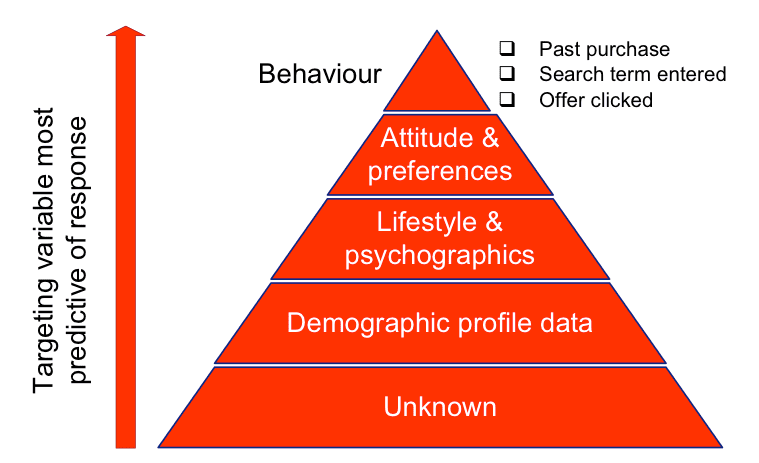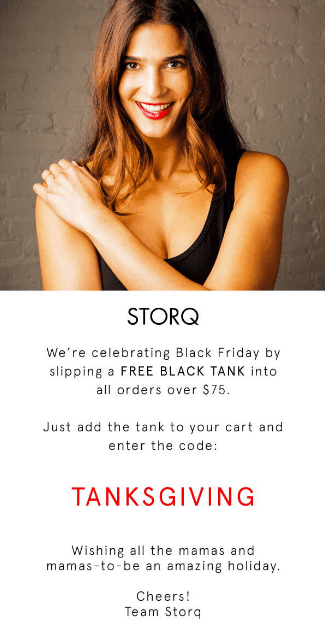Key 2017 email marketing trends you need to consider when creating your email communication strategy
As we move from one year to the next, the heart of (email) marketing remains the same. It is about providing customer-centric experiences. For email experiences, this is the mantra of right message, right person, right time. The closer you get to this the better the results. Each year
This is simple to say, but has been incredibly hard to deliver. Broadcast email has been so effective because of the high cost and limited accuracy of solutions to get right message, right time and right person. That’s changing, but don’t dump your broadcast activity just yet.
Trend 1 - Targeting
The best brands will be capturing behaviour across channels using it to improve customer targeting. The channels in which a brand’s customers are active is brand specific, but in most cases that means email clicks, website browse, mobile App activity, telesales and purchase behaviours.
Capturing user interests with preference centres is dead in all but a few specialised cases, or used as a last ditch recovery attempt as part of an unsubscribe opt-down. Brands not using behaviour in 2017 will be brands stuck in the past.
The cost of doing this is coming down to levels that means there is ROI in the extra effort needed. Some ESPs are building in such capabilities, even MailChimp added behaviourally generated product recommends in 2016. There are an increasing number of third-party solutions designed to work with any ESP that add this capability too.
Brands with a very large number of SKUs, or highly varied content and a diverse audience are behaviour to target content within emails. Highly dynamic emails in which much if not all of the content is specific to the individual. This is modern day segmentation.
eBay is a great example of the challenge and solution. eBay emails are full of content target based on personal behaviours; items browsed, purchased, added to watch lists or recommended based on others with similar behaviours. With the range of products on eBay and a huge diverse customer base this is the only way eBay can maintain relevance at scale.
I expect to see more brands of medium scale adding in blocks of behavioural driven content, such as recommended items, to classically generated static content.
For brands in niche markets with smaller highly focussed lists and limited product ranges then behavioural targeting of content is not as critical but behaviour is beneficial to use in the next trend. Automation.
However, don’t expect 2017 (or 2018… or possibly ever) to see perfection in technology for getting the right message/person/time combination. Relatively untargeted broadcast communication continues to have a place as part of the mix in 2017. A means to learn and elicit new behaviours.
The same behavioural data also naturally allows more lifecycle marketing; treating suspects, prospects, new customers, regular, lapsing and lapsed appropriately. Turning a one-time buyer in a multi-purchaser is the initial starting point for anyone who doesn’t yet have any lifecycle targeting.
Personalised discount offers fit hand in glove fit with lifecycle marketing. Who gets a discount, by how much and when individually targeted based on the lifecycle using and traditional RFM models. However, personalised offers are proving slow to become wide spread due to the relatively low penetration of capable solutions. The trend in 2017 will be for an increase but likely to remain at a small percentage of brands with this capability.
To review the options, take a look at these 6 email segmentation and targeting options.
Trend 2 - Automation
Rather than switching to automation, brands should be supplementing existing email activity and blending in automation programs to supplement broadcast activity.
In fact, many brands already have elements of automation included in their email programmes and they will be adding to this in 2017. But due to inherent limitations in email automation, nobody should be consider stopping use of using any broadcast, albeit broadcast content driven by behavioural data as in trend 1.
The best trigger points for automation are those which show high intent for conversion and happen with reasonable frequency. For example, someone adding a product to their wish list could be a great trigger point, but if your customer base almost never does that then such a trigger point has little value.
I expect that a few adventurous brands will try out innovative approaches to decisioning of what emails to send to each contact. Potentially using AI like technology. This is needed for brands well advanced with automation using classic pre-set business rules or flow chart automation. As complexity of automation increases, oversight of what is communicated to an individual contact is lost. There is every possibility of a contact getting many automated emails as they get triggered into several automated programs concurrently. Better traffic control solutions need to be found.
Trend 3 – Inbox placement and deliverability
The main ISPs have been hugely successful over the last few years with filter algorithm development. Indiscriminate and illegally sent email has been beaten. Whilst users may still see a little spam, what they don’t see is the massive amount that never gets to their inbox or even their junk folder.
Reputation of sending IP addresses and domains are the main drivers of inbox placement at the major ISPs.
B2B spam filtering may have lagged behind the sophistication of Gmail, Microsoft and Yahoo algorithms but that’s changed. In addition to the reputation sharing B2B filtering solutions such as Barracuda and Cloudmark there is a strong trend for companies to outsource email services to Office 365 and G-Suite (formally Google for Work). Gartner report 13% of public companies use these services. And this number is growing.
This means the same filtering and globally shared reputation based approach applies to B2B. The bar is rising on the standards needed for B2B brands to get to the inbox. Poorly permissioned, third party permissioned or sending on opt-out basis is going to be an increasing challenge for B2B.
As the ISPs continue to finesse algorithms they are recognise that one person’s spam is another person’s ham. Filter rules will work increasingly at the personal level and may lead to filtering of permission-based email from the inboxes of the users that are consistently ignoring the brand.
Seed list based inbox monitoring tools no longer give usable inbox placement results. Inbox placement is best monitored by tracking open rates over time by domain – a report that currently not all ESPs provide. The trend is for more brands to make use of the free Google Postmaster report to track their reputation with Gmail.
This last year has seen a noticeable increase in email list bombing. The resulting trend is going to be increased need to use reCAPTCHA on subscribe forms and/or use of double opt-in processes.
Getting to the inbox won’t be challenge for brands who work on the trends 1 and 2 above, but continuing with the status quo will mean more challenges to inbox placement.
Trend 4 – Data regulation and privacy
It’s clear that regulation is going in one direction only, both in the EU and worldwide. Permission is getting stricter; what marketers can do with data is going to be more tightly regulated.
In Europe the General Data Protection Regulation (GDPR) is agreed. We can expect to see privacy regulation changes too, as it needs to keep in step with data protection.
The ICO has confirmed that GDPR will be adopted, as implementation is required before the Brexit timetable. Even after a Brexit has been completed any brands marketing into the EU will need to obey GDPR. The long term worst case for brands could be obeying GDPR for EU residents and different regulations for UK.
In the UK the ICO has issued more fines for illegal marketing this year than ever before and we can expect to see even more fines in 2017.
Whilst the ICO focus has been on the area of most frustration to consumers, illegal phone and SMS campaigns, the Telegraph Media Group were fined £30,000 for sending an email with content for which they did not have permission. Permission is limited to the scope given at time of opt-in.
As the Digital Economy Bill and GDPR make their way into UK law, within the next two years, the requirement for unambiguous consent looks like it may end the practice of pre-ticked check boxes for email permission during a purchase. Using an un-checked box that can be easily ignored will slash list growth and marketers are going to have to work harder at growth and find stronger reasons to gain permission. The change might be to requiring an explicit yes or no to force an active choice, so that the option of permission can’t be ignored.
The ongoing situation with Safe Harbor being declared insufficient for passing data was resolved in 2016 with the EU Privacy Shield agreement. Right now EU brands using services that places their data on servers in the US have an issue.
Trend 5 – Email creatives
A few brands have experimented with pushing the envelope of email design, such as creating carousel type elements, hamburger menus and interactive features in their emails. Often called interactive emails.
However, it’s far from clear whether this is actually a good thing. Some of the design innovations in 2016 are dubious in value. I’ve seen clever designs that make it harder to access content by requiring extra clicks to see all content, whereas a simple linear design showing everything with scrolling would be better.
Carousels have been proven by CRO experts to be bad on webpages, why should they be a good thing in emails? Whilst hamburger menus are possible in email, these have been shown to make content harder to discover by Nielsen.
Also, not all email clients are able to support the very leading edge approaches, Gmail in particular. Though Google is moving to make Gmail support the latest standards, expect more improvements in 2017.
You might decide 2017 is not the year to experiment with interactive emails if you’ve limited resource and wait for a better understanding of what interactive elements improve email rather than just look flashy.
Expect to see the trend for use of animation and to a lesser extent video to continue in 2017. The key is to make the animation support the message and capture imagination, not just add a pointless decorative element.
When it comes to copy the trend for enterprise brands to get computer support of copy will continue. Solutions such as Persado, Phrasee or virtual testing with Touchstone.
After the initial big splash about smart watches there is still no sign of a big impact to email marketing. You’ve bigger things to win on in 2017 than worrying about if your emails are good for smart watch users.
Perhaps Google Home Assistant and Amazon Echo will start reading out your emails. If and when this becomes common, then subject lines may need to become more descriptive as voice control is used to triage emails. Again, not something for 2017! But check back next year…
from Blog – Smart Insights http://www.smartinsights.com/email-marketing/5-trends-email-marketers-need-stay-top-2017-couple-things-can-safely-ignore/
via Tumblr http://euro3plast-fr.tumblr.com/post/155385974594




No comments:
Post a Comment